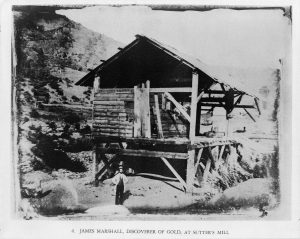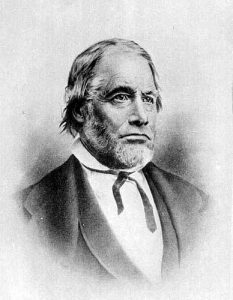
Sutter Mill
LACIE SILVA – Editor
A sawmill under construction in January 1848 led to the California Gold Rush of ’49.
James Marshall partnered with John Sutter to build a sawmill in the Coloma area, located just 45 miles away from Sutter’s Fort. It was along this stretch of the south fork of the American River that Marshall found nuggets of gold flowing through the mill’s tailrace. James Marshall conducted several tests to confirm that the nuggets he found were pure gold. Jennie Wimmer, a recent settler whose husband Peter worked for Sutter, was reportedly the only woman at the camp and the only person having ever seen real raw gold with her own eyes. One of the tests to confirm the gold was real was conducted by Jennie who was making lye soap in a boiling pot, which contained caustic potassium carbonate. She confirmed it was real gold when it came out of the pot completely unchanged. Sutter would later conduct his own test and reaffirm its authenticity.

James Marshall
Marshall and Sutter desperately attempted to keep the secret to themselves. They were unsuccessful and as word spread not only was there a flood of settlers and miners, the men working in Sutter’s Mill deserted Marshall and Sutter in search of gold. The influx began modestly but swelled in May when word of the strike and a sample of gold dust were shown in San Francisco that the floodgates were opened.
Almost overnight the port, a once thriving settlement, turned into a near ghost town as merchants, sailors, soldiers, and laborers rushed to the newfound gold fields. Before long more gold-seekers joined in the hunt from all over the state. As news of the gold discovery reached beyond California, a diverse array of nationalities enriched the dynamic tapestry of the gold fields. These included Mormons from Utah, farmers and trappers from neighboring Oregon, seasoned miners from Mexico and Chile, white sailors and merchants, native workers from Hawaii, and Chinese immigrants from the province of Kwangtung near Canton.
The composition of the immigrant wave in 1848 is due to geography and the technology at the time, with few “forty-eighters” hailing from the United States. The lack of telegraph lines or a railroad meant that word of the gold strike had to traverse the Pacific Coast by ship, circumnavigate South America, or cross the Isthmus of Panama—journeys taking six to seven months. In contrast, the sea voyage to China covered 7,000 miles in just three months. This delayed and tentative transmission of news and stories from the people to the eastern United States in 1848 dissuaded many from embarking on the arduous journey to California.
The transformation of the situation owed much to the efforts of a young Army officer, William Tecumseh Sherman. In June 1848, Sherman convinced his superior, California’s military governor Colonel Richard Barnes Mason, to personally inspect the gold fields and substantiate the reports of abundant wealth specifically along the American River.
Following Governor Mason’s report, President Polk officially declared the gold strike in his State of the Union message to Congress on December 5, 1848. This formal confirmation set off a widespread migration to California, with the “Forty Niners” embarking on their journey.
Ironically, neither Sutter nor Marshall ever profited from their discovery. Disheartened, Marshall wandered through California in pursuit of another lucrative discovery. In 1857, he returned to Coloma and ventured into winemaking in the early 1860s. Although initially successful, his vineyard faced competition and dwindling demand, leading to its closure by the end of the decade. Marshall spent his remaining years in Kelsey, residing in a modest homesteader’s cabin and sustaining himself through a small garden until his passing on August 10, 1885. His body was interred in Coloma on the vineyard property, overlooking the south fork of the American River. A monument with a bronze statue of Marshall pointing to the historic site was erected in 1890, commemorating his impact on California’s history.
The Marion Tribune – November 30, 2023










